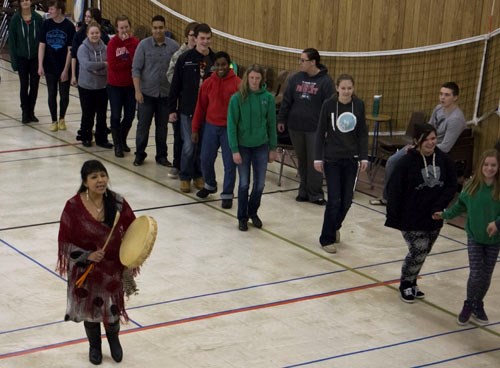The month of February was Aboriginal Storytelling Month in Saskatchewan. To celebrate this the Southeast Regional Library through the Arcola branch welcomed Aboriginal artist, Carol Daniels, to do a presentation for the grades one to six, as well as a second presentation for the grades seven to 12, at Arcola School.
Daniels began by explaining the significance of storytelling in Aboriginal culture and the importance of February being Aboriginal Storytelling Month.
“Stories are held in high regard in our culture,” Daniels stated. “We tell stories all year round, but when we lived in teepees and the weather was bad like it is in February they would want to stay inside. They would tell stories to entertain themselves and learn.”
Daniels, who is an artist and writer, told stories which were brought to life through art that she had created. The one story followed the progression of a young girl from a rural community in northern Saskatchewan to being accepted into a nursing program in Regina. This story she used to reinforce to the attending youth that their dreams are within reach if they work hard and think positively.
“Adults will tell you that you can do whatever you want and you can, but you have to work for it and make it happen,” Daniels stated. “You can pursue your dreams.”
Additionally she taught the youth about the differences of peoples across Canada, but more importantly about the similarities. One of her stories in fact involved an Inuit man from Nunavut who won a trip to Saskatchewan to the Tunnels of Moose Jaw.
Daniels asked the students to imagine how it might be for someone who lived in the Arctic, where food, scenery, and infrastructure is vastly different. Though seeing a golden canola field or sea of purple flax is part of the everyday in Saskatchewan during the latter part of summer, it was new to Daniels’ character, the same way going to the arctic and seeing an iceberg would be.
One of the other interesting and educational points Daniels brought up was the ways the First Nations drums sound. She then proceeded to play hand drums made of deer hide, elk hide, and an Inuit drum which was made with a synthetic fiber.
Each one she had the youth close their eyes and imagine the deer leaping through the landscape or a large elk gracefully moving through the prairie. The final drum she played was the Inuit drum, which she depicts a whale hunt in Nunavut in the way it is played.
“Inuit hand drums were actually made of drift wood, because there are no trees up there, but drift wood would find its way to the shores from other places and the drums were made out of trees that were from places like Australia or elsewhere,” Daniels said. “To me it’s neat how it was then fashioned into a drum.”
Both sessions for the students in Arcola were finished with a round dance for the youth to take part in. The presentation was ultimately a celebration of youth and of the First Nations culture.



